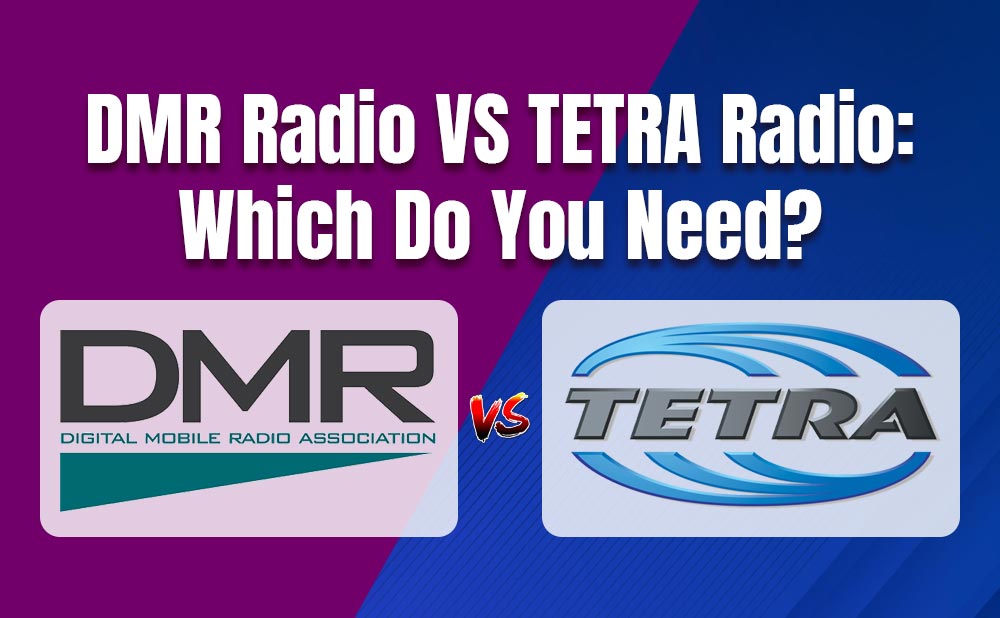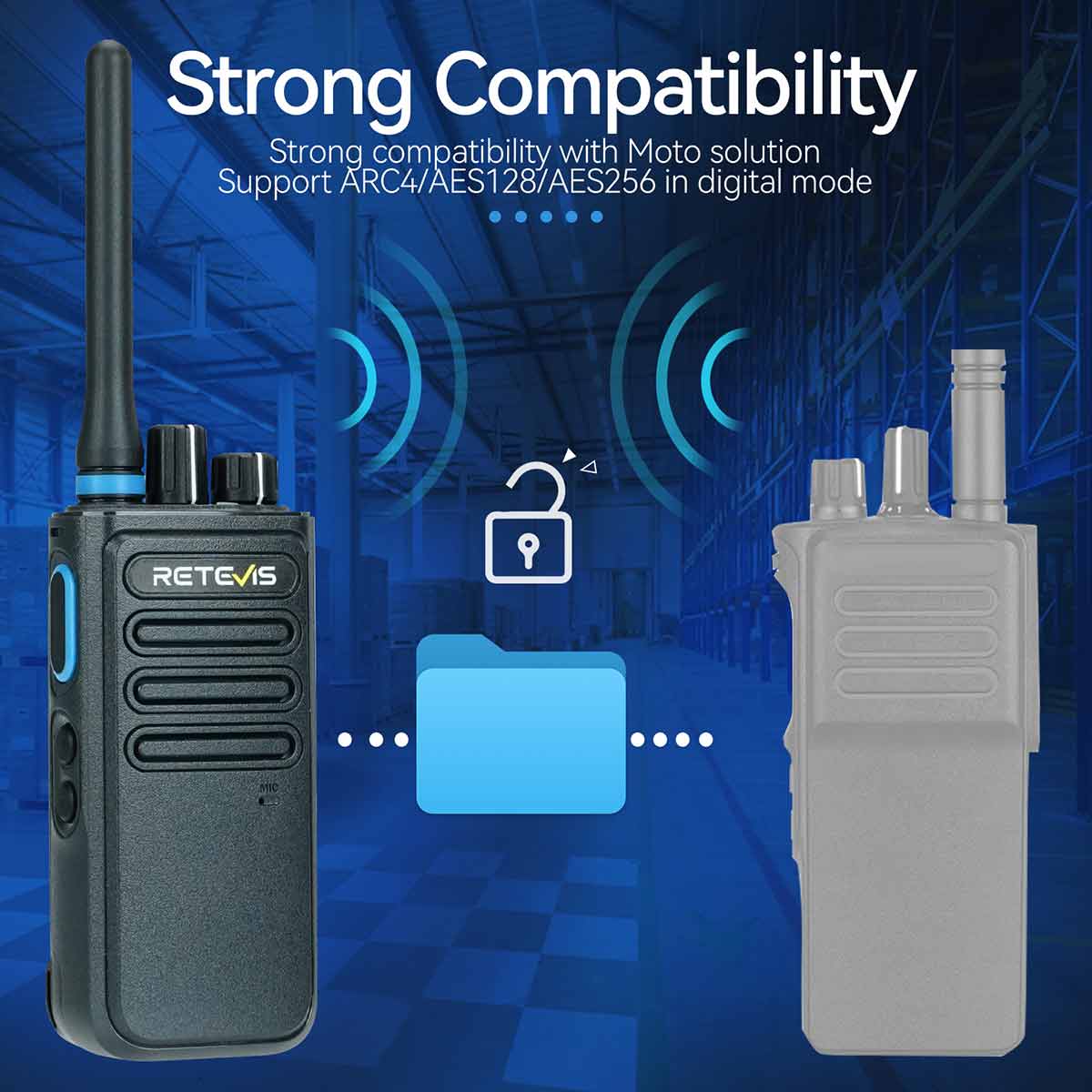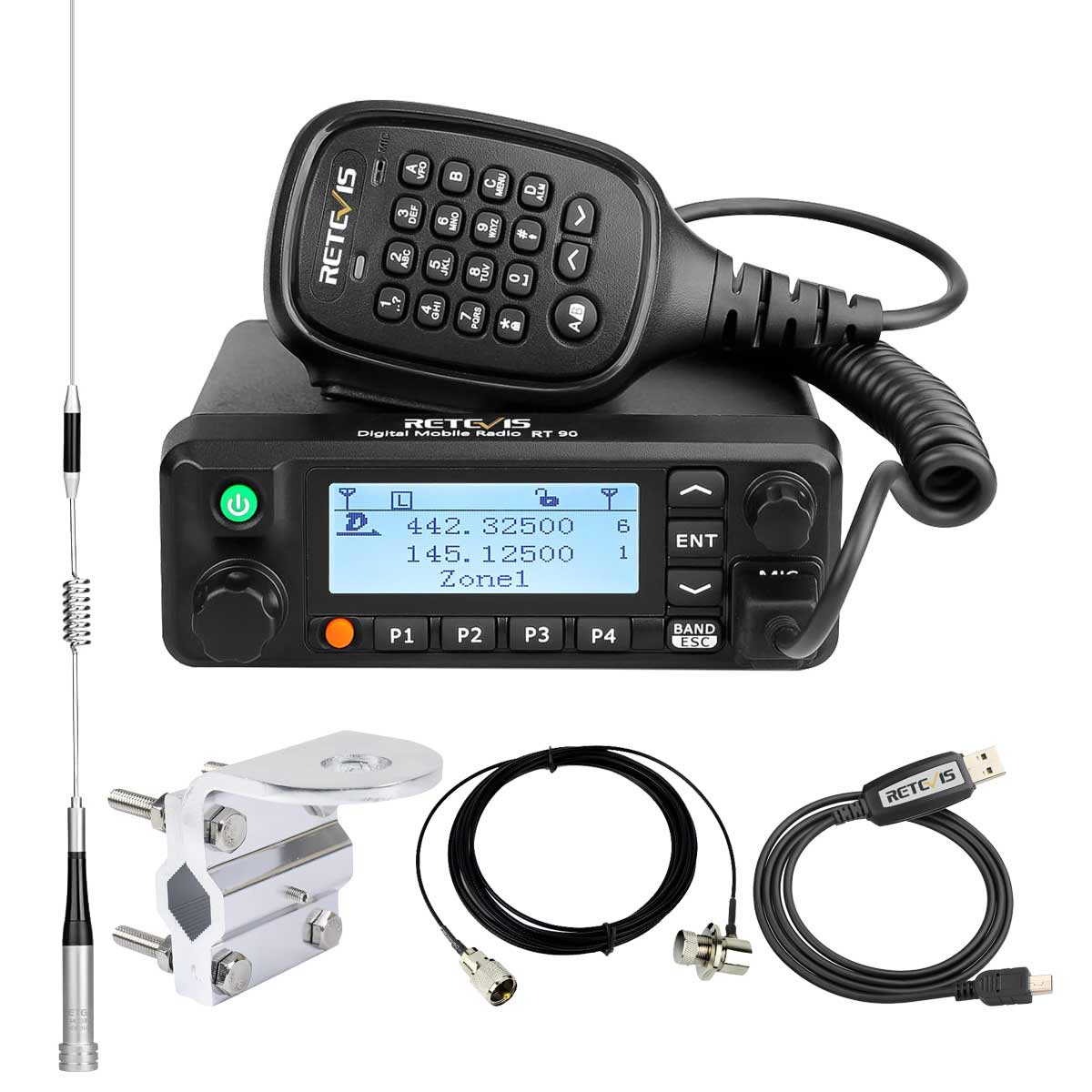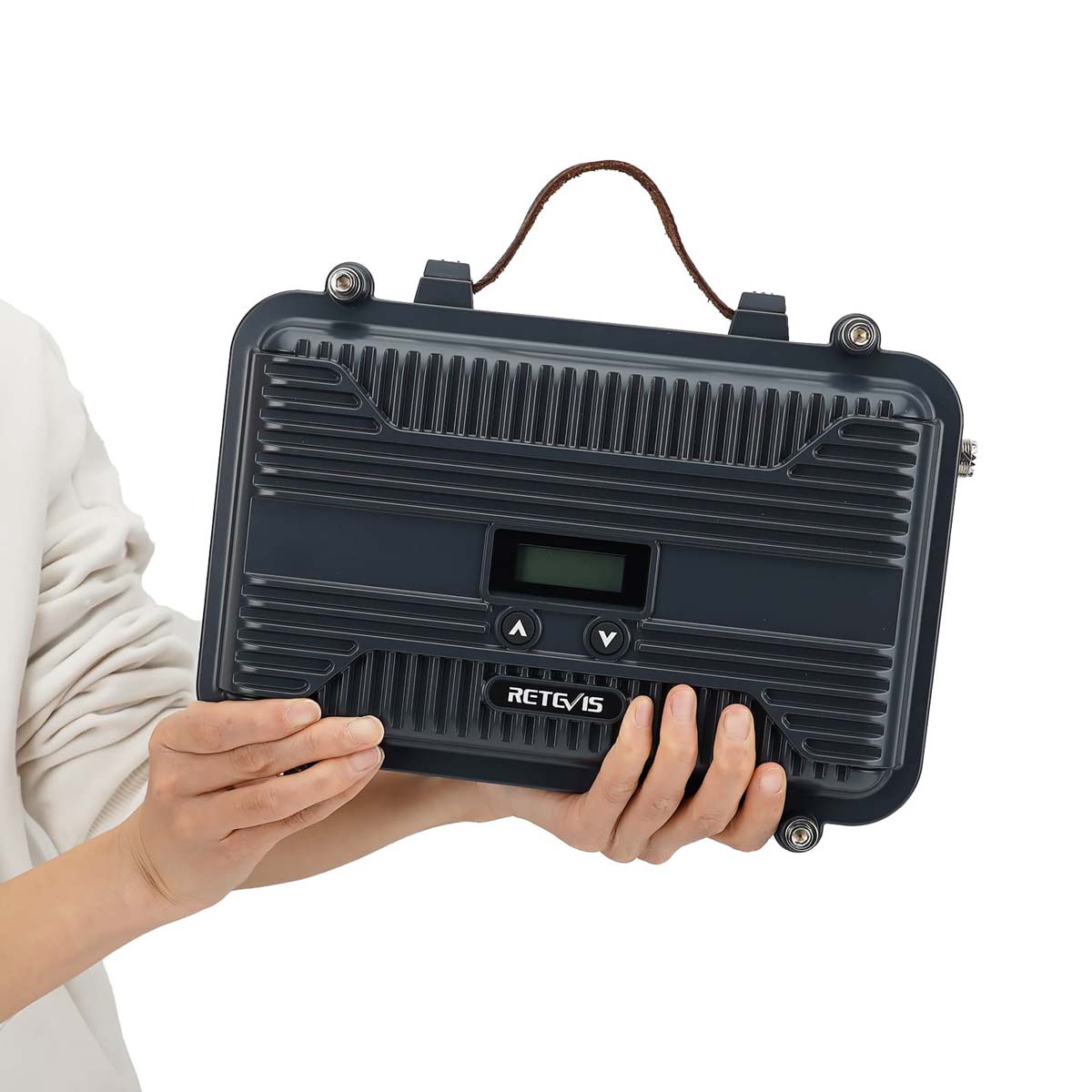DMR Radio vs TETRA Radio: Which Do You Need?

DMR Radio vs TETRA Radio: Which Do You Need?
Introduction to DMR and TETRA
Digital Mobile Radio (DMR) and Terrestrial Trunked Radio (TETRA) are two prominent digital radio communication standards endorsed by the European Telecommunications Standards Institute (ETSI). DMR emerged in the early 2000s, primarily aimed at commercial applications such as business communications, security, and transport services. Its main advantages include simplicity, interoperability, and efficiency in bandwidth usage, making it suitable for organizations using devices like the Retevis P1, Retevis RT90, and Retevis RT97P. These devices exemplify the flexibility and cost-effectiveness of DMR, catering to a variety of everyday communication needs in the commercial sector.
On the other hand, TETRA was developed around the same time but targets public safety and emergency services, such as police, fire departments, and medical response teams. TETRA systems are built to provide robust, secure communications in challenging environments, emphasizing reliability, interoperability among various agencies, and real-time communication capabilities. This makes TETRA highly regarded for critical applications where clear and uninterrupted communication can mean the difference between life and death.
The fundamental differences between DMR and TETRA can often be traced back to their design philosophies and intended applications. DMR is typically favored in business sectors due to its affordability and ease of use, while TETRA remains the gold standard for agencies requiring secure and resilient communication frameworks. As we delve deeper into the specifics of each system, it is crucial to understand not just the technical specifications but also the particular use cases that drive organizations to choose between these two digital radio technologies.
Key Features and Standards
The digital mobile radio (DMR) standard was first published in 2012 by the European Telecommunications Standards Institute (ETSI). DMR employs Time Division Multiple Access (TDMA) technology, allowing for group and individual calls as well as text messaging, which enhances communication efficiency. The tiered structure of DMR, divided into three tiers, serves distinct operational needs. DMR Tier I is aimed at licensed-free operations, while Tier II caters to commercial users with mandated licensing. Tier III supports trunked operations, making it suitable for larger network infrastructures and managing dynamic user demands.
In contrast, TETRA (Terrestrial Trunked Radio) was established as a standard for digital trunked radio technology, with its initial specifications issued in the mid-1990s. TETRA's architecture emphasizes high security and interoperability across various user groups, making it the preferred choice for public safety organizations. It utilizes a unique trunked principle, which allows multiple users to share a common frequency band effectively, leading to increased spectrum efficiency. Unlike DMR, which can operate without trunking capabilities, TETRA's design inherently revolves around trunked operations, enhancing communication in crowded environments.
The operational methods of both DMR and TETRA highlight their respective advantages regarding capacity and flexibility. DMR's two-slot TDMA can support up to two simultaneous conversations on a single frequency, which is beneficial for smaller-scale users seeking cost-effective solutions. On the other hand, TETRA’s efficient handling of voice and data allows users to maintain communication even when the network is under heavy load, making it ideal for critical missions. Each protocol's specifications underline their suitability for different user groups, whether for personal use with devices like Retevis P1 or for more expansive networks involving Retevis RT90 and Retevis RT97P devices.
Coverage Comparisons
When deliberating between DMR (Digital Mobile Radio) and TETRA (Terrestrial Trunked Radio), understanding their coverage capabilities is vital for making an informed decision. DMR radio is advantageous because it can utilize existing analog FM infrastructure, thereby offering a seamless transition for users looking to upgrade their systems without incurring substantial new expenses. By leveraging this established infrastructure, organizations can achieve extensive coverage with reduced investment risks.
In contrast, TETRA, while theoretically designed for comprehensive coverage in critical communication scenarios, may not always meet practical expectations. Evidence from practical experiences suggests that despite TETRA's intended specifications, coverage might be less optimal in certain environments, particularly in urban settings where tall buildings and obstacles impede signal propagation. Therefore, users might find themselves needing more infrastructure investments to achieve the expected performance levels.
Moreover, when analyzing site requirements for comparable coverage between DMR and TETRA, it becomes evident that the site density for TETRA is generally higher. This translates into additional costs and logistical challenges. For example, systems like the Retevis P1 may successfully operate within existing sites due to their DMR capabilities, whereas Retevis RT90 and Retevis RT97P units may necessitate a more complex site planning process for TETRA installations.
Ultimately, while both systems can provide effective communication solutions, the practical implications of coverage reveal different considerations. DMR radio holds an upper hand when integrating into established networks, while TETRA may require additional effort for coverage achievement, thus leading to differing operational experiences. Evaluating the actual coverage capabilities alongside the infrastructure already in place will help users determine the best fit for their communication needs.
Frequency Bands and Licensing
The choice of frequency bands is a crucial factor when considering digital radio systems, particularly between digital DMR radios and TETRA systems. DMR (Digital Mobile Radio) offers a significant advantage due to its flexibility in frequency deployment. Users can operate DMR systems within a wide range of frequency bands, including VHF (Very High Frequency) and UHF (Ultra High Frequency). This versatility allows for tailored solutions accommodating the unique communication needs of various users—from amateur radio enthusiasts to corporate communication networks. The Retevis P1, for example, showcases how DMR radios can be employed across these bands, ensuring seamless communication.
In contrast, TETRA (Terrestrial Trunked Radio) is generally established on a set frequency band, often within the 380-470 MHz range. This limitation can pose challenges for users transitioning from analog systems that traditionally operated across diverse frequencies. Consequently, the rigid frequency assignment of TETRA means users must adapt their communication strategies considerably, potentially resulting in increased costs and time delays during migration. Moreover, licensing for TETRA systems is notably stringent compared to the more permissive licensing protocols typically associated with digital DMR radios, such as the Retevis RT90 or RT97P, which facilitate easier access for users aiming for instant connectivity.
This distinction in frequency flexibility and licensing requirements contributes to the overall user experience. Organizations seeking scalable and adaptable communication solutions may find that digital DMR radio systems meet their needs more effectively than TETRA systems. As a result, the implications of frequency band selection should be a central consideration when evaluating the right system for existing and future communication requirements.
Fallback Capabilities
When evaluating the fallback capabilities of digital communication systems, the differences between digital DMR radios and TETRA radios become quite apparent, particularly regarding their adaptability during transitions. Modern digital DMR radios, such as the Retevis P1, Retevis RT90, and Retevis RT97P, exhibit a remarkable feature that enables them to revert to analog FM mode. This capability is pivotal for users who are in the process of upgrading from traditional analog communication systems to more advanced digital platforms. The ability to seamlessly switch back to analog mode ensures that users can maintain operational continuity while adapting to new technologies, mitigating any risks of disruption in communication.
In contrast, TETRA radios do not possess a similar fallback capability. This absence complicates the transition for users who wish to migrate from analog systems to TETRA technology. Without the option to revert to analog FM, users may find themselves in a challenging position, particularly if they encounter issues with their digital connections or if the infrastructure in their region is not fully compatible with TETRA systems. The inability to fallback to analog means that organizations must invest significantly in training, hardware, and infrastructure to ensure a smooth transition, as there is no safety net should complications arise.
The implications of these differences are far-reaching. Organizations considering the implementation of either system should factor in their communication needs, existing infrastructure, and long-term goals. For those looking to gradually phase in digital DMR radios, the Retevis line provides a robust solution, allowing for both immediate advancements in communication technology and the reassurance of fallback options. Conversely, TETRA users must approach the commitment to this system with full awareness of its constraints and the potential challenges associated with migration.
Cost and Ease of Migration
The transition from traditional analog radio systems to digital solutions like digital DMR radio and TETRA can be a pivotal moment for organizations seeking improved communication capabilities. However, the costs and complexities involved in migration can differ significantly between these two technologies.
Digital Mobile Radio (DMR) offers a more cost-effective transition option due to its compatibility with existing analog infrastructure. Many organizations already utilizing analog radios can integrate DMR with relative ease, allowing for a gradual transition without the need for immediate wholesale replacement. For instance, devices such as the Retevis P1, Retevis RT90, and Retevis RT97P often support mixed modes, enabling users to operate alongside current analog systems while moving towards digital capabilities. This flexibility can alleviate budget constraints as organizations do not have to bear the burden of a complete overhaul all at once.
Conversely, migrating to TETRA tends to involve a far more substantial financial investment. TETRA systems often require new licenses, specialized infrastructure, and entirely new hardware that is designed specifically for TETRA operations. These factors can significantly raise the overall cost of migration, making it a less accessible option for smaller organizations or those with tight budgets. Additionally, TETRA's higher complexity and stringent requirements may necessitate investment in training personnel, further increasing migration costs.
Organizations must therefore weigh these factors carefully when considering a shift to digital radio technologies. The ease of integrating digital DMR radio solutions can be a compelling advantage, particularly for those looking to minimize costs and disruption during the migration process. As digital communication continues to evolve, understanding the nuances of transitioning to DMR or TETRA will be critical for making informed decisions that align with an organization's operational goals.
Use Cases and Practical Applications
When evaluating communication systems, organizations must consider their specific needs and the environments in which they operate. Digital mobile radio (DMR) and Terrestrial Trunked Radio (TETRA) systems serve different purposes and cater to various sectors. DMR radio possesses advantages in broad coverage and cost-effectiveness, making it suitable for a wide range of applications.
One prominent application of DMR radio is within commercial sectors, where businesses such as construction, transportation, and hospitality utilize devices like the Retevis P1 and Retevis RT90. These devices provide reliable communication across expansive geographical areas, ensuring teams remain connected without incurring excessive expenses. The scalability of DMR systems allows organizations to expand their communication capabilities as their operations grow. Moreover, DMR radios offer features such as voice, data, and short message service (SMS), enhancing operational efficiency.
On the other hand, TETRA radio is specifically designed to meet the requirements of mission-critical communication in dense urban environments. This makes it particularly beneficial for public safety organizations, such as police, fire, and ambulance services. The ability to prioritize emergency calls and maintain uninterrupted communication is crucial for these sectors. TETRA systems excel in high-density areas, providing excellent voice clarity and reliability even in challenging surroundings.
Additionally, TETRA can facilitate interoperable communication between different agencies, which is vital during emergencies. Its robust encryption and security features also appeal to organizations that require secure and reliable information transfer. As such, while DMR provides a cost-effective solution for many industries, TETRA's advanced capabilities make it the system of choice for organizations needing a more resilient communication infrastructure.
In conclusion, the choice between DMR and TETRA radios hinges on the specific use cases and operational requirements of an organization. Each system offers unique advantages that can significantly impact the success of communication efforts within various sectors.
Interoperability Testing Standards
Interoperability is crucial in communications, particularly for emergency services and public safety agencies. When analyzing the differences in interoperability between digital DMR (Digital Mobile Radio) and TETRA (Terrestrial Trunked Radio), it is essential to consider the testing standards that govern these systems. The testing procedures for DMR and TETRA are distinct and cater to different operational contexts and user needs.
Digital DMR, defined by the ETSI (European Telecommunications Standards Institute) standards, has a flexible approach to interoperability testing. This flexibility allows manufacturers such as Retevis, which produces devices like the Retevis P1 and Retevis RT90, to innovate while ensuring compatibility across various equipment. DMR’s interoperability is typically tested through equipment compliance with these standards, ensuring that devices can work seamlessly within different networks. This becomes particularly significant in emergency response scenarios where multiple agencies need to communicate effectively despite having varied equipment.
On the other hand, TETRA employs a more rigorous and structured testing framework, which is mandated by its own set of standards developed by ETSI. TETRA networks aim for a high level of interoperability, especially in mission-critical situations. For example, the Retevis RT97P is designed to meet TETRA specifications, which facilitates reliable communication in emergencies involving multiple agencies. TETRA's testing often involves comprehensive assessments, including environmental tests and interoperability assessments that ensure every device operates as intended within complex networks.
The differences in these testing standards ultimately mean that organizations choosing between digital DMR radio and TETRA radio must carefully consider their specific requirements. The compatibility and ease of integration of devices, such as the Retevis offerings, can significantly influence communication efficiency during critical operations. In conclusion, understanding these interoperability standards is vital for effective communication in challenging scenarios.
Conclusion: Making the Right Choice
As organizations and individuals navigate the complexities of communication technologies, the decision between digital DMR radio and TETRA radio systems becomes increasingly significant. Each technology offers distinct advantages that cater to different operational needs, and understanding these can greatly inform your choice.
Digital DMR radio, particularly models such as Retevis P1 and Retevis RT90, is lauded for its efficient use of spectrum and cost-effectiveness. DMR systems are often favored for their versatile applications in various sectors, from recreational use to professional fields like security and service industries, due to their scalability and ease of integration. Additionally, users can benefit from features such as enhanced audio clarity and digital signal processing, which contribute to overall communication efficiency.
Conversely, TETRA radio systems are often preferred in critical communications environments, such as emergency services and public safety. The resilience, security, and reliability of TETRA systems, including models like Retevis RT97P, align closely with the rigorous demands of these sectors. TETRA's robust capabilities in group communications and high-profile interoperability make it an exceptional choice for organizations requiring streamlined and secure communications in demanding situations.
Ultimately, the choice between DMR and TETRA should reflect the specific requirements of your operational objectives. Consider factors such as budget constraints, the scale of communications, required features, and the operational environment. By adequately assessing these elements, you can determine which radio system best suits your needs, ensuring effective communication and operational success.









